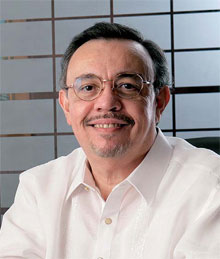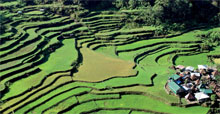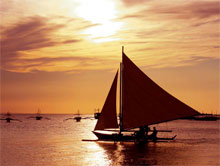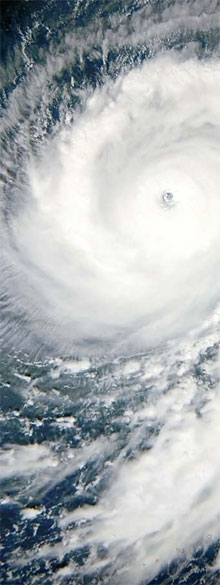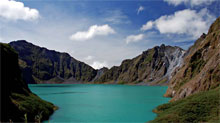Enrique Clemente III: President and CEO MAPFRE Insular The Philippines MARKETS
Enrique Clemente III or EC3 as he is known to his colleagues has been in the financial sector, more particularly the non-life insurance industry, for more than three decades.
He was involved in all aspects of operations in general insurance until he assumed the Presidency of MAPFRE Insular.
EC3 is the product of a Christian Brothers’ education and obtained his degree in Business Administration from the De La Salle University in Manila.
In the past decade, MAPFRE Insular has gained ground in the Philippine setting and is now one of the top companies in the Philippine insurance industry.
"In this financial crisis, Asia has had a major advantage"
How would you outline the insurance Market
in the Philippines?
Licenses or Certificates of Authority (CA) of
regulated insurance entities expire every June
30 of each year. For the licensing period 2008-
2009, a total of 121 insurance companies were
granted licenses to transact business in the
country. These are composed of 3 composite
companies, 32 life companies, 85 non-life
companies and 1 reinsurance company. Also
issued during the year, were licenses/
accreditations of 49,781 insurance intermediaries
and other technical support entities.
The licenses include 40,865 ordinary
agents, 233 general agents and 7,683 variable
agents and 113 brokers.
The total premiums generated by both life
and non-life insurers amount to about PHP
100 Billion annually with total life and nonlife
premiums computed at about 1.05% and
0.95% of the GDP and GNP, respectively. The
combined assets of life and non-life sectors
amount to about PHP 500 Billion with the
bulk of investments in government securities.
The ratio of the insurance business in the
Philippine market is 60:40 for the life and
non-life sectors, respectively.
What are the most common insurance products
sold in the Philippine Market?
Traditional insurance products continue to
account for a good portion of the life portfolio
but variable link products have been gaining
ground over the years. For the non-life sector,
Property and Motor account for more
than 60% of the portfolio with profitable loss
ratios over the years. The official loss ratio
for underwriting year 2009, however, has not
yet been released.
For non-life, the bulk of the Motor business
is accounted for by private and commercial
vehicles with own damage, theft and acts of
nature coverages. Liability premiums, including
compulsory liability, account for the
balance.
For Property, industrial and commercial enterprises
account for a good portion of the
premiums with retail and residential business
accounting for the balance.
For the Casualty line, Personal Accident (PA)
and health would be the principal products
sold with micro PA products gaining ground
as these are sold through various intermediaries
all over the country.
Pre-need products, like educational and memorial
plans have experienced a decline over
the past couple of years but sales are again
slowly picking up. This sector, which was
directly supervised by the Securities and Exchange
Commission, will now be under the
supervision of the Office of the Insurance
Commissioner.
A new branch or product that could evolve in
the coming years is “Title” insurance which
was recently introduced in the Philippine
Congress. This insurance, which is required
in North America, is in connection with real
estate transactions.
Do you find any points in common with the
giant neighbor Japanese market? What are
the main surrounding markets where The
Philippines is more involved?
Similar to the Philippine insurance industry,
the Japanese market is deregulated. Developed
and developing countries undertook
financial liberalization programs in the 1990s
to improve competitiveness and efficiency.
There was an easing of restrictions on both
domestic and foreign entry in Southeast Asia
in the second half of the 1990s. Deregulation
has led to the entry of new players (including
foreign companies) and mergers and acquisitions.
Based on 2008 data, Japan's major lines of
business are Motor (59.5%) and Fire (15.9%).
These two lines are the Philippines' top major
lines as well. Fire contributed 32.65% and
Motor generated 31.69% of the non-life insurance
industry's gross premiums in 2008.
Motor and Fire are also the top major lines
in Thailand (60% Motor, 7% Fire) and Indonesia
(29% Motor and 34% Fire).
Both markets are dominated by a few top
companies. In Japan, 85% of market is controlled
by 17 companies out of 51 players.
There is a plan for these 17 companies to
consolidate into three holding companies.
This situation may lead to an oligopoly in the
Japanese non-life insurance industry. On the
other hand, the Philippine market is dominated
by the top 20 out of 85 licensed non-life companies in 2009. They account for 80% of
the industry's total gross premiums written.
For Life, the top 5 account for about 80% of
the business.
In contrast with the Japanese market where
insurance penetration is about 2.2%, the
Philippines´ penetration average is much
lower when compared to Japan. Other Asian
countries have a penetration ranging from
0.6% (India) to a high of 2.9% (Taiwan). The
Philippines is similarly situated as other
Southeast Asian countries. Singapore, Malaysia,
and Thailand register penetration rates
of about 1.1%, 1.6%, and 1.7% respectively.
The underdeveloped insurance industry in
most of Southeast countries may be attributed
primarily to low demand as a result of low
levels of income.
A favourable tax structure for the industry is
a key driver of insurance market development.
The Philippines is one of the most heavily
taxed markets where Fire policies are levied
a 27% tax and Motor policies a 25% tax. The
Philippine Life insurance industry has recently
successfully lobbied for the enactment of a
law to reduce taxes on life insurance policies.
This reduction is expected to increase affordability
and penetration of the life insurance
market.
The largest distribution channel in Japan is
the agency system which accounts for 93%
of the direct premiums written in the market.
This is in contrast to the Philippines where
close to 50% of the industry's total non-life
premium production is generated by insurance
brokers.
Japan, Philippines and other Asian countries
also utilize other distribution channels such
as direct marketing (including internet sales)
and Bancassurance.
Southeast Asian non-life insurance industries
such as the Philippines, Malaysia, Indonesia,
and Thailand are in varying stages
of implementing the Risk-Based Capital adequacy
framework. On the other hand, Japan
is observing the Solvency Margin criteria for
regulation.
A favourable tax structure for the industry is a key driver of insurance market development
In 1997, the Asian crisis in the insurance
markets was an issue; did it really finish or
has it overlapped with the present financial
crisis in the Western countries?
The 1997 Asian Financial crisis started in
Thailand with the financial collapse of the
Thai baht and caused a financial contagion
to other Asian countries. Indonesia, South
Korea, and Thailand were the worst-hit countries.
By 2001, Thailand's economy had recovered.
The increasing tax revenues allowed
the country to balance its budget and repay
its debts to the IMF in 2003, four years ahead
of schedule. The Thai Baht continued to
appreciate to 33 Baht to the Dollar in December
2009.
The 1997 Asian financial crisis ended years
before the present financial crisis in Western
countries started. This rebound did not happen
spontaneously, but came about as a result of
steadfast policy implementation by the affected
countries and large-scale financial support
from the international community, especially
under IMF-supported programs for Indonesia,
Korea, and Thailand.
The present financial crisis in Western countries was triggered by the subprime mortgage
crisis in the US in late 2006. This sent
shockwaves throughout financial markets
around the world including Asia. Asia's exportdependent
economies suffered badly when
consumers and industries in the US and Europe
cut down on their purchases. The financial
turmoil has exposed excessive risk-taking by
financial institutions. It has also highlighted
the need to improve the regulatory framework,
foster good corporate governance, and enhance
the quality of our markets. Heightened
monitoring of financial and solvency positions
of insurance companies will increase confidence
in the sector as well as protect the
insuring public.
In this financial crisis, Asia has had a major
advantage. Most Asian banks steered clear
of the complex financial instruments that
caused some Western banks to collapse.
Asian governments and companies were in
relatively sound financial health, having repaired
their finances only recently after the
Asian financial crisis of 1997-98.
The present financial turmoil has highlighted the need to improve the regulatory framework, foster good corporate governance and enhance the quality of our markets
Do you think that a Regional Hub for financial
services could be created in the Philippines,
in the same way as Singapore or Labuan?
A Regional Hub for Financial Services could
be created in the Philippines similar or as an
alternative to Singapore's and Labuan's. It
would take legislative action to do it. Creating
such a Financial Hub with tax breaks and
incentives would be nothing new to the country
as the Philippine Government has done
this for EcoZones or Export Processing Zones.
Obtaining sponsorship from Congress would
not likewise be difficult since it has long been
recognized that such special zones and the
like are good for the country as they spur
economic growth, generate employment and
enhance the image of the country as a global
economic player. The question really is whether
or not it would be necessary at this point
in time, taking into consideration the financial
climate and the proximity of other dominant
financial centers.
What is the level of penetration of insurance
of natural hazards in The Philippines? What
is the greatest “market loss” following a
catastrophic event? Does reinsurance play
a main role in natural hazards insurance in
The Philippines?
Industry Figures show that only about 11% of
the property risks written have been insured
against natural hazards. For Motor, there is
unfortunately no available data but an educated
estimate would be about 10% to 20%.
The greatest market loss following a catastrophic
event is the recent massive and widespread
flooding brought about by tropical storm
Ketsana (local name Ondoy).
The property losses adversely impacted on
the real estate value of properties in the
affected areas. Motor losses are further
aggravated by the inability of certain car dealers
to deliver spare parts for the repair of
the damaged vehicles, at times putting insurance
companies in a losing predicament of
declaring “total loss” claims. Insurance companies
have agreed to charge policyholders
0.5% for the Motor extension or to be able to
avail of the additional coverage for natural
perils or so-called "Acts of Nature." Because
of the Ketsana catastrophe, motor vehicle
owners now appreciate the importance of
securing this additional coverage extension.
Actual figures are not yet available but the
combined insured losses for Property and
Motor have been placed between PHP 12 to
15 Billion by the Philippine Insurers and Reinsurers
Association (PIRA) with Property losses
accounting for 90% thereof.
Reinsurance plays a major role in natural
hazards insurance in the country. Firstly,
local players have relatively low retention
capacities. On a risk-to-risk basis, the larger
accounts are generally the ones who require
cover for natural perils. If there is no reinsurance
capacity available, insurance could be
limited to co-insurance arrangements. Secondly,
direct insurers have to be wary with
the risks aggregates they accumulate.
Without enough CAT protection, a prudent
company would have to go slow or be more
selective in accepting cover against natural
perils.
The images of Pinatubo volcano eruption in
1991 and lahars triggered afterwards are
still in our minds. Is it possible to remember
any lessons learned following that crisis?
What would be necessary to reduce loss of
lives, damage and economic loss regarding
natural perils in your country?
The Mount Pinatubo eruption was one of the
most devastating calamities the Philippines
had ever experienced, killing over 800 people
and destroying thousands of homes. The
effect was of a global magnitude as well because
as scientists had revealed, the eruption
decreased the temperature worldwide over
the next few years.
What cannot be ignored is the fact that man
is really powerless to stop these acts of nature
and can only find ways of avoiding possible
loss of lives and properties. In the case of
Mt. Pinatubo, the ensuing rampage of lahar
flows triggered by rains and storms that came
even years after brought more devastation to
the people affected than the eruption itself
disrupting lives, taking lives or livelihood, and
costing millions of pesos of rehabilitation
efforts that seemed to drag on. It pays to have
a disaster-control and prevention plan that can only be made successful through the joint
efforts of the government, the local residents,
and socio-civic organizations. Regular campaigns
and information dissemination through
training and use of mass media need to be
done in order to make the people aware of
and appreciate the disaster preparedness
plan. This should include a disaster prevention
advocacy that can touch on a wide range
of areas from waste management, clean air
program, to improving livelihood and community.
In this way, there is a serious and conscious
effort to mitigate the impact of natural
calamities whenever they strike. While it took
a few years to pick up the pieces, Central
Luzon which was badly affected by Pinatubo
eventually rebounded and recovered well and
is now a very strong economic region.
Philippine industry figures show that only about 11% of the property risks written have been insured against natural hazards
Strong typhoons very frequently slam into
The Philippines, but they do not always cause
economical and insured losses even if hitting
populated areas. What do you think is if the
key factor for high insured losses following
natural events?
Serious economical and high insured losses
occur when a typhoon/weather disturbance
hits the main island of Luzon, more specifically
Metro Manila, Central Luzon and
Southern Luzon where there is a big concentration
in terms of population and economic
activity. The bulk of insurance premiums come
from the island of Luzon and major insurance
risks are, therefore, situated on the Main
Island. In addition to this, the paths of the
more powerful typhoons normally veer to
Luzon, thereby causing major destruction.
Following typhoon Ketsana, motor vehicle owners now appreciate the importance of securing “Acts of Nature” as an additional coverage extension
Why was the flood event last September 2009
following tropical storm Ketsana especially
catastrophic?
Last September 2009, tropical storm Ketsana
passed through the Luzon Island and brought
about the heaviest recorded rainfall to Metro
Manila and Calabarzon region despite its only
moderate winds. Rains that lasted around 9
hours caused severe flooding which forced
President Gloria Macapagal-Arroyo to declare
a "state of calamity" in most of Luzon, with
80% of the Metropolis submerged in floodwaters.
According to the weather bureau,
Ketsana dumped in those hours, a total of
410.6 millimeters (16 inches) of rain, which
was greater than the average monthly rainfall
usually experienced by the country and much
more than “Katrina”. Flood water levels
reached a record of 20 feet high in rural areas.
The flooding was further aggravated by the
release of waters from some of Luzon's dams
and overflowing of rivers. Power lines were
cut and not completely restored until the
places were free of floodwater. With the onslaught
of Ketsana, the government reported
at least 500 deaths and more than 300,000
people displaced. Industrial, commercial,
residential, and agricultural losses were
substantial, especially as the waters rose
quickly and most of the areas affected
remained submerged for a period of 2 days
to even months. The flooding affected all
socio-economic classes of society.
How did MAPFRE Insular help coordinate
the relief efforts, both on a corporate level, liaising between FUNDACION MAPFRE and
the local NGO's, and also on a more personal
level, what was the involvement of the employees.
MAPFRE Insular was very pleased and grateful
with the generous assistance given by
Fundación MAPFRE which enabled us to
provide relief goods to people affected by
typhoons Ketsana of September 2009 and
Parma in October that year. Upon learning
of this donation, we started coordinating
with NASSA-Caritas Philippines Foundation
through the Sisters of St. Paul, for the immediate
preparation of the relief goods.
NASSA-Caritas is a local Catholic organization
offering social services to the marginalized.
The funds from the Fundación were
gradually released to NASSA-Caritas to be
able to purchase “family kits” containing
basic food and personal items which were
then packed in thousands of sacks that bore
the name of Fundación MAPFRE. MAPFRE
Insular helped select the goods to be included
in the sacks.
More than a hundred MAPFRE Insular employees
and agents volunteered to help Caritas
in the packing of goods which took weeks to
do, and personally distribute them to the
8,500 families in the affected areas of Calamba,
Muntinlupa, Benguet, La Union and Pangasinan.
The Filipino values of “pagtulong” and
“damayan” (giving help and empathizing) became
much evident in the willingness of employee-
volunteers to be a part of the relief
efforts. Their working under uncomfortable
physical conditions in order to prepare and
deliver the goods on more than one occasion
was just an indication of their compassion
for the victims.
As for the MAPFRE Insular employees who
were victims themselves, it was heartwarming
to see how their co-employees initiated the
raising and pooling of funds from their own
pockets and across the organization in order
to buy relief goods for the victims and give
some cash to tide them over.
The calamity brought people together and
gave us the chance to extend our hand in the
best way we could to those in need.
After this experience, how do you think, from
a corporate point of view, that Contingency
Plans could be enhanced when catastrophic
events take place to assist employees,
clients and population in general?
MAPFRE Insular will continue with its commitment
of helping would-be employeevictims
by extending assistance in various
forms. Information campaign through our
intra-office network, newsletter, and employee
forums will also timely feature relevant
topics or programs that would touch on disaster-
prevention or coping with disasters.
A similar information campaign using available
media (company website, flyers, newspapers
and client newsletter) will be advocated,
up to the extent of educating them on
how to preserve property (residences, establishments,
motor vehicles) especially
should they be affected by catastrophes.
Likewise, we will ensure that the claims
servicing team would be beefed up in times
of anticipated large volume of claims during
calamities.
Finally, as part of MAPFRE Insular's corporate
social responsibility, we will continue to do
our share in helping uplift the quality of life
by partnering with agencies (as how we did
it with NASSA-Caritas) in community assistance-
activities.
In a country such as the Philippines that is prone to the mentioned natural hazards, the local scientific community, borne out of necessity, has developed a high level of knowledge and awareness on Risk Management.
At the forefront of Risk Management in the country concerning natural hazards for the local scientific community and authority are the Philippine Atmospheric, Geophysical and Astronomical Services Administration (PAGASA), the Philippine Institute of Volcanology and Seismology (PHIVOLCS), and the National Disaster Coordinating Council (NDCC).
PAGASA is the government agency under the Department of Science and Technology (DOST) that does the weather forecasting, flood forecasting, astronomical observations, and time service. The agency follows the international warning systems that provide the necessary and timely information to the public concerning atmospheric disturbances that can affect the country. Aside from proactively interacting with the media in information dissemination, it maintains a website accessible to the public from where real time or up-to-date information can be obtained as data are gathered and analyzed by its team of weather specialists and hydrologists. One of its programs to improve risk awareness, preparedness and mitigation is Hazard Mapping and Vulnerability Analysis. From information and observational data gathered on meteorological and hydrological hazards in terms of nature, frequency and magnitude, and then relating them to human settlement and its built environment (assets), the agency presents its analyses in the form of hydrometeorological maps that show the places and frequency of occurrences of hydrometeorological hazards such as tropical cyclones, flooding, storm surge, extreme wind and extreme rainfall and their impact to lives and properties. These studies and maps are used in the development and implementation of risk control, disaster preparedness and mitigation plans and programs by the government agencies and nongovernmental organizations (NGO). PHIVOLCS, on the other hand, is the service institute of the DOST, which is principally mandated to mitigate disasters that may arise from volcanic eruptions, earthquakes, tsunami and other related geotectonic phenomena. It is the agency responsible for the development and dissemination of information of such natural hazards. It therefore handles earthquake and volcano monitoring and mapping, active faults mapping, ground deformation studies, and developing and implementing the necessary warning and alert systems.
The NDCC is the government's top and overall coordinator of the country's disaster preparedness programs, disaster operation and rehabilitation efforts undertaken by the government and private sector. It is headed by the Secretary of National Defense and assisted by the heads (Secretaries) of 18 other government agencies or departments which include that of the Armed Forces of the Philippines, Office of the Civil Defense, and that of the Philippine National Red Cross. It operates through its member agencies and through its local networks from its regional down to its local (barangay) coordinating councils.
As proof of the country's awareness in risk management on natural hazards, an act was recently passed in Congress known as The Philippine Disaster Risk Reduction and Management Act of 2010. Said act defines the roles of specified branches of government tasked to respond in times of disaster and institutionalizes the national disaster risk reduction and management plan and the appropriate funding thereof.
http://www.dost.gov.ph/
http://www.pagasa.dost.gov.ph/
http://www.phivolcs.dost.gov.ph/
http://www.ndcc.gov.ph/
http://en.wikipedia.org/wiki/Typhoon_Ketsana
